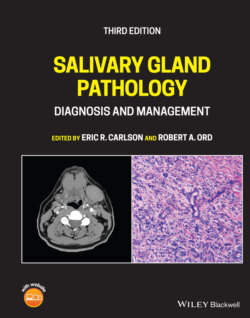Читать книгу Salivary Gland Pathology - Группа авторов - Страница 99
Malignant Tumors Mucoepidermoid carcinoma
ОглавлениеMucoepidermoid carcinoma is the most common malignant lesion of the salivary glands. They are also the most common salivary malignancy in the pediatric population. One half occur in the parotid gland and the other half in minor salivary glands (Jansisyanant et al. 2002; Shah 2002). The imaging characteristics of mucoepidermoid carcinoma are based on histologic grade. The low‐grade lesions are sharply marginated and inhomogenous, mimicking PA and Warthin tumor. These well‐differentiated lesions can have increased signal on T2 weighted sequences. The low‐grade lesions are more commonly cystic (Madani and Beale 2006b). The high‐grade, invasive lesions mimic adenoid cystic carcinoma and lymphoma or large heterogeneous PAs or carcinoma ex‐pleomorphic adenoma. They tend to have a lower signal of T2. Contrast‐enhanced studies demonstrate enhancement in the more solid components (Sigal et al. 1992; Lowe et al. 2001; Bialek et al. 2006; Madani and Beale 2006b) (Figures 2.64 through 2.66 ). Therefore, standard imaging cannot exclude a malignant neoplasm. Defining the tumor's extent is critical. Contrast MRI, especially in the coronal or sagittal plane, is essential to identify perineural invasion into the skull base.
